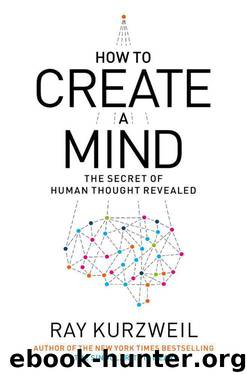How to Create a Mind: The Secret of Human Thought Revealed by Ray Kurzweil

Author:Ray Kurzweil [Kurzweil, Ray]
Language: eng
Format: epub, mobi
Tags: Life Sciences, Future Studies, Social Science, Azizex666, Science, Neuroscience
ISBN: 0670025291
Google: FCcXiBPurdEC
Amazon: B007V65UUG
Barnesnoble: B007V65UUG
Publisher: Penguin
Published: 2012-11-13T05:00:00+00:00
A Strategy for Creating a Mind
There are billions of neurons in our brains, but what are neurons? Just cells. The brain has no knowledge until connections are made between neurons. All that we know, all that we are, comes from the way our neurons are connected.
—Tim Berners-Lee
Let’s use the observations I have discussed above to begin building a brain. We will start by building a pattern recognizer that meets the necessary attributes. Next we’ll make as many copies of the recognizer as we have memory and computational resources to support. Each recognizer computes the probability that its pattern has been recognized. In doing so, it takes into consideration the observed magnitude of each input (in some appropriate continuum) and matches these against the learned size and size variability parameters associated with each input. The recognizer triggers its simulated axon if that computed probability exceeds a threshold. This threshold and the parameters that control the computation of the pattern’s probability are among the parameters we will optimize with a genetic algorithm. Because it is not a requirement that every input be active for a pattern to be recognized, this provides for autoassociative recognition (that is, recognizing a pattern based on only part of the pattern being present). We also allow for inhibitory signals (signals that indicate that the pattern is less likely).
Recognition of the pattern sends an active signal up the simulated axon of this pattern recognizer. This axon is in turn connected to one or more pattern recognizers at the next higher conceptual level. All of the pattern recognizers connected at the next higher conceptual level are accepting this pattern as one of its inputs. Each pattern recognizer also sends signals down to pattern recognizers at lower conceptual levels whenever most of a pattern has been recognized, indicating that the rest of the pattern is “expected.” Each pattern recognizer has one or more of these expected signal input channels. When an expected signal is received in this way, the threshold for recognition of this pattern recognizer is lowered (made easier).
The pattern recognizers are responsible for “wiring” themselves to other pattern recognizers up and down the conceptual hierarchy. Note that all the “wires” in a software implementation operate via virtual links (which, like Web links, are basically memory pointers) and not actual wires. This system is actually much more flexible than that in the biological brain. In a human brain, new patterns have to be assigned to an actual physical pattern recognizer, and new connections have to be made with an actual axon-to-dendrite link. Usually this means taking an existing physical connection that is approximately what is needed and then growing the necessary axon and dendrite extensions to complete the full connection.
Another technique used in biological mammalian brains is to start with a large number of possible connections and then prune the neural connections that are not used. If a biological neocortex reassigns cortical pattern recognizers that have already learned older patterns in order to learn more recent material, then the connections need to be physically reconfigured.
Download
How to Create a Mind: The Secret of Human Thought Revealed by Ray Kurzweil.mobi
This site does not store any files on its server. We only index and link to content provided by other sites. Please contact the content providers to delete copyright contents if any and email us, we'll remove relevant links or contents immediately.
| Computer Vision & Pattern Recognition | Expert Systems |
| Intelligence & Semantics | Machine Theory |
| Natural Language Processing | Neural Networks |
Algorithms of the Intelligent Web by Haralambos Marmanis;Dmitry Babenko(7860)
Hadoop in Practice by Alex Holmes(5664)
Jquery UI in Action : Master the concepts Of Jquery UI: A Step By Step Approach by ANMOL GOYAL(5517)
Life 3.0: Being Human in the Age of Artificial Intelligence by Tegmark Max(4521)
Functional Programming in JavaScript by Mantyla Dan(3726)
The Age of Surveillance Capitalism by Shoshana Zuboff(3432)
Big Data Analysis with Python by Ivan Marin(3091)
Blockchain Basics by Daniel Drescher(2896)
The Rosie Effect by Graeme Simsion(2716)
WordPress Plugin Development Cookbook by Yannick Lefebvre(2625)
Hands-On Machine Learning for Algorithmic Trading by Stefan Jansen(2541)
Test-Driven Development with Java by Alan Mellor(2540)
Applied Predictive Modeling by Max Kuhn & Kjell Johnson(2487)
Dawn of the New Everything by Jaron Lanier(2441)
Data Augmentation with Python by Duc Haba(2387)
The Art Of Deception by Kevin Mitnick(2304)
The Infinite Retina by Robert Scoble Irena Cronin(2260)
Principles of Data Fabric by Sonia Mezzetta(2202)
Rapid Viz: A New Method for the Rapid Visualization of Ideas by Kurt Hanks & Larry Belliston(2201)
